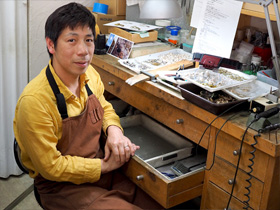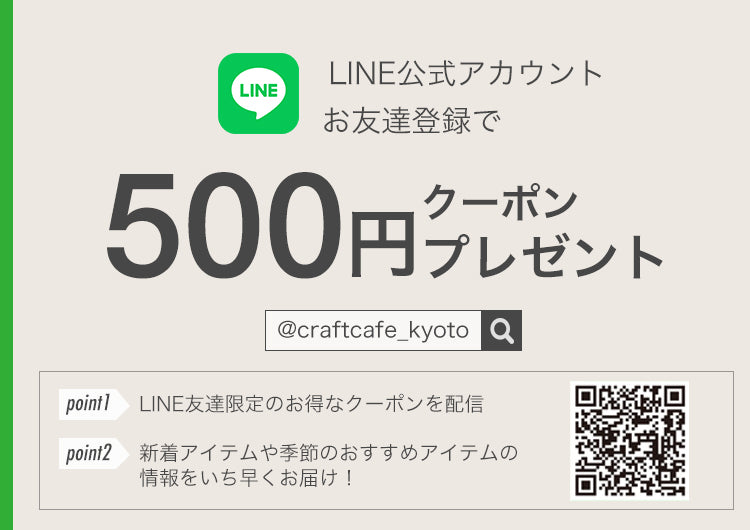銀工房AramaRoots(naturama ナチュラマ) ・ 加藤心姿さん

作業用の大きな机が構えられた工房にて。使い込まれた道具が積み重ねられた手仕事の確かさとストイックな創作姿勢を語ります。
今回お訪ねした「銀工房AramaRoots(naturama ナチュラマ) 」は、2000年に加藤心姿(しんし)さんが立ち上げたアクセサリーブランド。
多彩なアプローチから創作される作品たちは、長く愛着をもって身につけられるアクセサリーとして多くのファンの心をとらえ続けています。その工房があるのは、天王山の西に広がる閑静な住宅街の一画。豊かな自然に恵まれ、数々の歴史の舞台ともなった神秘の地は、 創作へのインスピレーションを育むにふさわしい場所です。職人気質とともに、多趣味でお茶目な一面も持ち合わせた加藤さんですが、その根底にある、もの作りへの熱い思いが伝わるインタビューとなりました。
立体作品を作りたいという欲求をアクセサリーに
─もの作りは小さな頃から得意だったんですか。
幼い頃に家族で京都に移り住んだのですが、もともと両親ともに出雲の出身で、祖父は仏像や仏壇をつくる職人でした。
祖父の仕事場の様子や木の匂いは、今もおぼろげに覚えています。その血を親戚で唯一ひいたのが僕だったみたいで、おもちゃの代わりに紙と鉛筆を与えられて、漫画を描いて満足しているような子どもでしたね。
わりと、まわりがびっくりするようなものを創作していました。高校も美術系に進んで、その頃から漫画家になりたいと思い、ずっと描いていました。結局、漫画家は断念したんですが、その後はゲーム会社でキャラクターデザインの仕事をしたり、フリーでグラフィックデザイナーをしたり、趣味でオブジェ的なものを作ってフリーマーケットに出たり…と、さまざまな形で創作にかかわってきました。
─紆余曲折はあれど、創作ひとすじだったんですね。その終着点がジュエリーデザイナーだった?
30代になったときに、立体的な造形をきちんと仕事になる形で学びたいと考え、働きながら宝飾の専門学校に通い始めました。トシも30を過ぎているし、これからはこれで食べていくんだという思いがあったので、貪欲に学びましたよ。
─その成果は早々に出たのですね。
まわりにも必死に働きかけたこともあり、ありがたくも友達の紹介などで、早い段階から注文のお声がけをいただくようになりました。
注文を受けてからわからないところは学校で先生に習いながら作るという状態でした。「銀工房AramaRoots」を立ち上げた2000年は、まだ在学中で昼間はサラリーマンでしたが、徐々に注文が増えてきて、なんとかこれ1本にシフトできた感じです。
結局、学校は3~4年通って覚えるべきことはほぼ覚えてから辞めました。

現在も根強いファンのため、ブランド初期のシルバーアクセも作り続けています。人気のアクセサリー専門誌『シルバーアクセ最強読本』の新鋭ブランド読者投票企画で2位に選ばれたことも。右のネックレス「ヴァジラ スタンダード」は密教法具がモチーフ。現在もクラフトカフェにて取り扱いさせていただいている作品です。
─ブランド名「Arama Roots」の由来は?
「私の魂」を意味するアイヌ語「Aram」と「道のり、起源」を意味する英語の造語です。「わが魂の起源」という意味になります。次代のアクセサリーのルーツになれるような魂のこもった作品を、という思いがこめられています。
アイヌ語を使っているのは、当初、アイヌ文様のジュエリーをつくっていこうと思っていたからなんです。でも数作で飽きて、作らなくなってしまった(笑)。
それからは、ハードなメンズ系のシルバーアクセサリー、中にバネを入れて動かしたりする、ギミックで凝ったものなんかを好んで作っていましたね。
─今とは全然違う作風ですね。
男の子ですから(笑)、やっぱりメカメカしたものやロボットが好きで。しかし労力と価格が釣り合わないという問題がありました(笑)。


シルバーアクセでご縁ができた俳優のお客さまの依頼で、あの世界的監督のディレクターズチェアを制作。背もたれの両端に天使のシルバー製オブジェが付けられたチェアは、映画「アキレスと亀」のパンフレットでも紹介されました。2008年の作品です。
その時の当店ブログはこちら。
手にする人の喜びが創作へのモチベーション
─現在のような女性向けのアクセサリーにシフトされたきっかけは?
百貨店の催事などで販売させてもらう機会が増えてからですね。やはり百貨店という性格上、来てくださるのは女性がほとんどだし、女性メインにしないとブランドとして成長できないと思ったので。
だんだん線を細くして、蝶や花など、自然をテーマにしたものを増やしていきました。
─テイストの全く違うものを作るのに、抵抗はなかったのですか。
始めはありました(笑)。でも。お客さんとのコミュニケーションの中で喜んでくださる姿を見たり、大切にしていただけることがわかったりすると、やっぱり凄く嬉しくて励みになりました。
それに当時の彼女…今の妻ですが、が、こういうもの、ああいうものという要望を言ってくれるので、なるべく聞くようにして。

加藤さんの奥様、直美さん。写真は京都で毎年、春と秋に開催される「京都アートフリーマーケット」の様子(2016年03月20日撮影)。
─今では「Arama Roots」の販売やウェブを担われている奥さま!まさに二人三脚は、そこから始まっていたのですね。
そうですね。猫なんかも彼女の要望で作り始めました。僕自身、猫は好きでずっと飼っていたのですが、作品にする気はなかったんです。
こういうリアルで立体的なものは世の中にあふれていたので、自分が作ることに興味がなかったんですね。もともと興味を持っていたのは、複雑なデザインだったから。
でも、10年以上アクセサリーを作ってきた中で、自分らしさを入れていく技術が身についたので、やってみようかと。
─加藤さんが手がけられる猫の特徴とは?
僕のは、たぶん漫画なんです。実際の猫をモデルにしながら作るのですが、そのままリアルな猫ではなくて、ほんの少し頭と目が大きく、胴が短い。僕なりの愛らしさを入れるというか、かわいいなと思うところを強調しています。
ただ、やりすぎると幼稚になるので、そこはバランスを注意しています。大人の女性のための猫ですね。

デザインやアイテム数も増えた猫シリーズ。お客様との対話のなかで、モデルチェンジすることも。

作品のモデルもつとめる、愛猫のグリとラテュは4歳のきょうだい(2016年5月現在)。三毛猫の方がメスの「グリ」、茶トラの方がオスの「ラテュ」です。

加藤さん「細い子がモチーフになっている作品はグリ、ちょっと丸い子はラテュがモデルです(笑)」。

お手頃な価格で好評の猫ピアス。左のだらんとした猫ピアスは「グリ」、右の丸まった猫ピアスは「ラテュ」がモデルです。
─猫に始まって、今では動物シリーズも広がっていますね。
お客さまのリクエストを聞きながら作っている部分も多いので、犬やうさぎも加わりました。特に犬のリクエストは増えていますね。まだまだ犬を作る作家は少ないので、注目していただいているのではと思います。
─本当にどの作品も愛らしいですが、作るときはどんなことを心がけていらっしゃいますか。
やはり生き物がモチーフですから、語りかけるような雰囲気を大切にしています。型があがってから一度いぶして、磨きをかけるのが最終工程になるんですが、毛並みの1本1本まで丁寧に、まさに魂を吹き込むつもりで仕上げます。
特に目だけは別に、光るいぶし加工をして、生きているような輝きを宿らせます。だから同じ型でも、できあがると一匹ずつ表情が違うんですよ。うちの子として、愛着をもっていただけたら、作家冥利につきます。



ミニチュアダックスの愛らしさをリアルに表現した犬リング。デッサン力を生かして絶妙のデフォルメで起こした型に、シルバーを流して成型。いぶしをかけたあと、通常の何倍も時間をかけて磨き込み、仕上げられます。
─それから加藤さんの代表作としてはずせないのが、モルフォ蝶のアクセサリーシリーズですね。最近ではドラマでも使用されて注文が殺到したそうですが。
今は落ち着いています(笑)。これは、イギリスの貴族が好んだアンティークの中にモルフォ蝶の羽をガラスにはさんで宝飾にしたものを見つけて、これを現代の技術でやりたい!と思い研究しました。
材料は、標本に使用できなかったモルフォ蝶の羽ですが、日本では扱っていないのでまずは輸入する方法から調べるなど、一から手探りでした。
ガラスではなく樹脂で再現するにはかなり工夫が必要でしたが、長く樹脂のアクセサリーを作ってきて技術を身につけていたので、巧く加工する技法が編み出せました。他の誰にも真似できないものが作れたと自負しています。
─樹脂であの美しさをどのように作品化されたかは、企業秘密ですね。
もちろん(笑)。でも、作り始めて5年になるのですが、申し分ないクオリティでできるようになったのは、正直、最近のことです。
その間、なんといっても樹脂など材料のクオリティが格段に進歩しました。今作っているものは完璧に近いです。ですから、以前買っていただいたお客さまのものも、ご要望があれば、材料費だけいただいてメンテナンスをして、ほぼ新品に近い状態に戻します。
モルフォ蝶に限らず、送り出した作品に関しては、すべてメンテを承っています。修理できない素材は使っていないので。

世界一美しい蝶といわれる「モルフォ蝶」の羽を使用したアクセサリー。その神秘的で鮮やかなメタリックブルーは、色素ではなく羽の表面の不思議な微細構造によって作り出されていて、光の角度によって表情が変わります。
今欲しいのはジュエリーを自在に彩る技術
─作品それぞれに加藤さんのこだわりを凝縮されていることがよくわかります。一作ごとに新しいことにチャレンジされている印象です。
新しい技術を開発したいという思いが常にあって。自分が目指す、憧れとするものを自分なりの形で世の中に出していきたいんですよね。 特に、アクセサリーに色を入れたいとずっと思い続けていて、そんな中でモルフォ蝶にも出会ったのですが、樹脂はやはり永遠不変というわけにはいきません。
色を入れるには、ガラス製のものを組み込んでいくのが一番なんです。すると、たまたま古本屋で見つけた本で、ルネ・ラリックという19~20世紀に活躍したフランスのジュエリー作家の作品に衝撃を受けました。それから調べれば調べるほどこの技術を自分のものにしたいと思うようになりました。

2016年10月、加藤さんはフランスへ。ガラスを使った作品作りの体験をされました。これをきっかけに、毎年フランスへ勉強へ行く事になったそうです。

ここからアラマルーツの新しい物語が始まりそう。ワクワクする瞬間です。
僕は手仕事でしか作れないものを作りたい。また、高級なものではなく、ポップで身近だけど安っぽくないものを提供したいと思っているんです。それにぴったりの技法だと思った。日本でいうと原理は七宝の技術と同じなんですが、それだけでは片付けられないものがあります。
ぜひこの技術を取り入れて自分の表現ができるようになりたいのですが、唯一、見つけた学べるところがフランスなんですよ。
─加藤さんの新境地、早く見たいです。
動くなら今しかないと思っているんですが、なかなか条件が整わなくて。幸い、昔から興味を持ったらまっしぐらという性格なので。まだまだ挑戦する意欲はあります。もう50歳ですから、最後の挑戦としてこの技術を身につけたいと思っています。

19世紀末から20世紀初頭に起こった美術運動「アール・ヌーボー」「アール・デコ」の両時代にわたって活躍したフランスのジュエリー作家、ルネ・ラリック。精緻な技を駆使したエマイユ・ジュエリー(ガラスと金属を組み合わせたジュエリー)の高貴な輝きは、今も人々を魅了し続けています。
日本では、伝統工芸の七宝焼き以外で、シルバーなどの金属とガラスを組み合わせた普段使いのアクセサリーはまだ少ないとのこと。ルネ・ラリックの作品は、加藤さんのこれからの創作活動のヒントになると考えているそうです。

2015年2月にはイタリア・ミラノのファッションフェア「ミラノ プレタ ポルテ」に出展。インタビューの時点(2016年5月)では未定でしたが、2016年9月に2週間ほどフランスに滞在し、ガラスを使ったアクセサリー制作技術を学ぶそうです。
加藤さんは落ち着きがあって、どちらかといえば物静かな感じの方ですが、そのチャレンジ精神と行動力はすごいです。

「ミラノ プレタ ポルテ」イベントポスターの前で。
─50歳なんて、まだこれからですよ。でも加藤さんは凄くポジティブですよね。
いや、小さい頃は引っ込み思案で気が弱くて、「どうせ僕なんか」って思ってる子でした。でもあるとき、気がついたんです。こんな考え方じゃダメだ、損ばかりしてる!悪い結果は全部自分で招いているんだって。それにはっきり気づいて、これからは考え方を変えようと思った瞬間を、今でも覚えてるんですよ。小学校にあがる前でした。
─それはずいぶん早熟な(笑)。
ですかねえ。でもそれから具体的にどう変わったかとか、人生がいい方向に進んで行ったのかとか、そういった記憶は一切ないんです。ただ、考え方として、常に前向きにはなりましたね。
─人生、どうにかなるって?
いや、「どうにかなる」ではどうにもならないです(笑)。ただ、なんとかしなきゃとそれに見合う努力をすることが基本だと思っています。ひと握りの天才は別としてね。
基礎力はとても重要だと思うし、僕はアクセサリーをやろうと思ったときに学校でみっちりと学んだので、時間はかかりましたが今も作家として活動できているのだと思っています。
いろいろまわり道もしましたが、たとえば頭の中で想像したものを立体的に形にできるのは漫画を描いていたおかげだし、努力してやってきたことがすべて、今の自分に役立っています。
─今後はどのような展開を目指しておられますか。
クラフトカフェさんにご紹介いただいて、異業種でもの作りに携わる人々とのつながりができたのは、本当によい刺激になっています。
みんなどんどん大きくなっていって、凄いなと思うし、ライバルとして意識もする。僕自身、本当に素晴らしい人々とのご縁に恵まれて、ここまでやってこれました。だからこそ、負けてはいられない。
作家ひとりの小さなブランドなのでそんなに手は広げられませんが、ゆくゆくは世界を相手に創作をしたいとも考えています。そのためにも、今の作品にヨーロッパのニュアンスをプラスしたくて、新しい技術を身につけることは必須なんです。
で、ゆくゆくは情熱大陸に出たい(笑)。何よりも自分が納得できて、より多くのお客さまに喜んでいただける作品を作り続けていくことが一番ですね。
─期待しています。ありがとうございました。
「自分は天才ではなく、普通の人。努力と縁と運だけでここまで来た」と語る加藤さんですが、求められる方向に照準を合わせつつ、作家としてオリジナリティのある作品に昇華する創造力もまた、稀有な才能ではないでしょうか。
柔軟にニーズに応えながらも、作りたいものに挑み続ける「芯」のある創作姿勢は、やはりアーティスト。これからどんな作品が生み出されていくのか、ますます楽しみになりました。
(愛猫のグリとラテュの画像、イタリア・ミラノの展示会の画像は、アラマルーツさんにご提供いただきました)
銀工房AramaRoots(naturama ナチュラマ) 加藤心姿さん プロフィール

1967年、島根県出雲市生まれ。仏像職人であった祖父の影響で、ものづくりへの興味は人一倍強く、豊かな想像力にも恵まれる。
その後京都へ移住。美術系学校を卒業後、グラフィックデザインやオブジェ制作の傍ら、日本宝飾クラフト学園に入学。シルバーアクセサリーの制作・デザインを学ぶ。
2000年に京都・大山崎にて「銀工房アラマルーツ」を設立。自らが納得のいく作品だけを、お客様にお届けされています。

